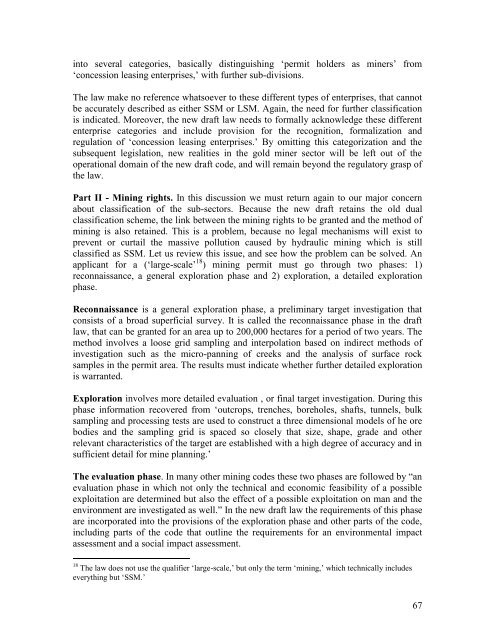SITUATION ANALYSIS OF THE SMALL-SCALE GOLD ... - WWF
SITUATION ANALYSIS OF THE SMALL-SCALE GOLD ... - WWF
SITUATION ANALYSIS OF THE SMALL-SCALE GOLD ... - WWF
You also want an ePaper? Increase the reach of your titles
YUMPU automatically turns print PDFs into web optimized ePapers that Google loves.
into several categories, basically distinguishing „permit holders as miners‟ from<br />
„concession leasing enterprises,‟ with further sub-divisions.<br />
The law make no reference whatsoever to these different types of enterprises, that cannot<br />
be accurately described as either SSM or LSM. Again, the need for further classification<br />
is indicated. Moreover, the new draft law needs to formally acknowledge these different<br />
enterprise categories and include provision for the recognition, formalization and<br />
regulation of „concession leasing enterprises.‟ By omitting this categorization and the<br />
subsequent legislation, new realities in the gold miner sector will be left out of the<br />
operational domain of the new draft code, and will remain beyond the regulatory grasp of<br />
the law.<br />
Part II - Mining rights. In this discussion we must return again to our major concern<br />
about classification of the sub-sectors. Because the new draft retains the old dual<br />
classification scheme, the link between the mining rights to be granted and the method of<br />
mining is also retained. This is a problem, because no legal mechanisms will exist to<br />
prevent or curtail the massive pollution caused by hydraulic mining which is still<br />
classified as SSM. Let us review this issue, and see how the problem can be solved. An<br />
applicant for a („large-scale‟ 18 ) mining permit must go through two phases: 1)<br />
reconnaissance, a general exploration phase and 2) exploration, a detailed exploration<br />
phase.<br />
Reconnaissance is a general exploration phase, a preliminary target investigation that<br />
consists of a broad superficial survey. It is called the reconnaissance phase in the draft<br />
law, that can be granted for an area up to 200,000 hectares for a period of two years. The<br />
method involves a loose grid sampling and interpolation based on indirect methods of<br />
investigation such as the micro-panning of creeks and the analysis of surface rock<br />
samples in the permit area. The results must indicate whether further detailed exploration<br />
is warranted.<br />
Exploration involves more detailed evaluation , or final target investigation. During this<br />
phase information recovered from „outcrops, trenches, boreholes, shafts, tunnels, bulk<br />
sampling and processing tests are used to construct a three dimensional models of he ore<br />
bodies and the sampling grid is spaced so closely that size, shape, grade and other<br />
relevant characteristics of the target are established with a high degree of accuracy and in<br />
sufficient detail for mine planning.‟<br />
The evaluation phase. In many other mining codes these two phases are followed by “an<br />
evaluation phase in which not only the technical and economic feasibility of a possible<br />
exploitation are determined but also the effect of a possible exploitation on man and the<br />
environment are investigated as well.” In the new draft law the requirements of this phase<br />
are incorporated into the provisions of the exploration phase and other parts of the code,<br />
including parts of the code that outline the requirements for an environmental impact<br />
assessment and a social impact assessment.<br />
18 The law does not use the qualifier „large-scale,‟ but only the term „mining,‟ which technically includes<br />
everything but „SSM.‟<br />
67
















